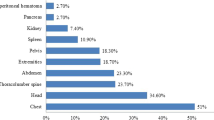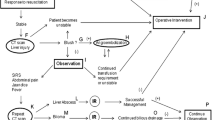Abstract
Purpose of Review
The purpose of this review is to discuss the indications for operative and nonoperative management in patients with blunt liver injuries.
Recent Findings
Over the past several years, research has begun to show that nonoperative management in blunt liver injuries is feasible and has favorable outcomes over immediate operations in patients who are hemodynamically stable. This includes high-grade injuries who were previously taken to the operating room, in the absence of peritoneal signs or instability, for washout and packing. This trend in management is likely multifactorial and includes improved quality of critical care medicine, advances in imaging to accurately define the injury and trend changes, and other interventional techniques such as embolization, percutaneous drainage and endoscopy. The mainstay of treatment for hemodynamically unstable patients remains operative.
Summary
This article will provide current recommendations for operative and nonoperative management strategies in patients with blunt liver injuries, taking into account initial clinical picture and resources available.





Similar content being viewed by others
References
Papers of particular interest, published recently, have been highlighted as: • Of importance •• Of major importance
Jiang H, Wang J. Emergency strategies and trends in the management of liver trauma. Front Med. 2012;6:225. doi:10.1007/s11684-012-0186-6.
•• Raza M, Abbas Y, Devi V, Prasad KVS, Rizk KN, Nair PP. Non operative management of abdominal trauma—a 10 year review. World J Emerg Surg. 2013;8:14. doi:10.1186/1749-7922-8-14. This reference examines 10 years of patients with liver injuries and concludes that nonoperative management is effective in managing blunt liver injuries with proper monitoring and protocols.
Van der Wilden GM, Velmahos GC, Emhoff T, Brancato S, Adams C, Georgakis G, et al. Successful nonoperative management of the most severe blunt liver injuries. Arch Surg. 2012;147(5):423–8. doi:10.1001/archsurg.2012.147.
• Moore EE, Cogbill TH, Jurkovich GJ, et al. Organ injury scaling V: spleen and liver. J Trauma. 1995;38(3):323–4. This reference provides the standard grading system to classify liver injuries.
Wahl WL, Ahrns KS, Brandt MM, Franklin GA, Taheri PA. The need for early angiographic embolization in blunt liver injuries. Journal of Trauma-Injury Infection & Critical Care 2002:52(6).
•• Ward J, Alarcon L, Peitzman B. Management of blunt liver injury: what is new? Eur J Trauma Emerg Surg. 2015;41:229. doi:10.1007/s00068-015-0521-0. This reference provides an overview of nonoperative imaging modalities and procedures to manage blunt liver injuries and surgical options when necessary.
Poon RTP. Current techniques of liver resection. HPB. 2007;9(3):166–73. doi:10.1080/13651820701216182.
Clark JJ, Steinemann S, Lau JM. Use of an atriocaval shunt in a trauma patient: first reported case in Hawai’i. Hawaii Med J. 2010;69(2):47–8.
Hsieh TM, Tsai TC, Liang JL, Lin CC. Non-operative management attempted for selective high grade blunt hepatosplenic trauma is a feasible strategy. World J Emerg Surg. 2014;9:15. doi:10.1186/1749-7922-9-51.
Peitzman AB, Ferrada P, Puyana JC. Surgical Infections 2009:10(5):427–433. Doi:10.1089/sur.2009.021
Polanco PM, Brown JB, Puyana JC, Billiar TR, Peitman AB, Sperry JL. The swinging pendulum: a national perspective of nonoperative management in severe blunt liver injury. J Trauma Acute Care Surg. 2013;75(4):590–5. doi:10.1097/TA.0b013e3182a53a3e.
Yoon W, Jeong YY, Kim JK, Seo JJ, Lim HS, Shin SS, et al. CT in blunt liver trauma. Radiographics 2005:25(1).
Latifi R, Khalaf H. Selective vascular isolation of the liver as part of initial damage control for grade 5 liver injuries: shouldn’t we use it more frequently? Int J Surg Case Rep. 2015;6:292–5. doi:10.1016/j.ijscr.2014.12.021.
Ahmed N, Vernick JJ. Management of liver trauma in adults. J Emerg Trauma Shock. 2011;4(1):114–9. doi:10.4103/0974-2700.76846.
Abdelrahman H, Ajaj A, Atique S, El-Menyar A, Al-Thani H. Conservative management of major liver necrosis after angioembolization in a patient with blunt trauma. Case Rep Surg. 2013;954050:1–4. doi:10.1155/2013/954050.
Yao DB, Wu SD. Application of stapling devices in liver surgery: current status and future prospects. World J Gastroenterol. 2016;22(31):7091–8. doi:10.3748/wjg.v22.i31.7091.
Dabbs DN, Stein DM, Scalea RM. Major hepatic necrosis: a common complication after angioembolization for treatment of high-grade liver injuries. J Trauma. 2009;66(3):621–7. doi:10.1097/TA.0b013e31819919f2.
Anand RJ, Ferrada PA, Darwin PE, Bochicchio GV, Scalea TM. Endoscopic retrograde cholangiopancreatography is an effective treatment for bile leak after severe liver trauma. J Trauma. 2011;71(2):480–5. doi:10.1097/TA.ob013e3181efc270.
Stassen NA, Bhullar I, Cheng JD, Crandall M, Friese R, Guillamondegui O, et al. Blunt hepatic injury, selective nonoperative management of. J Trauma. 2012;73(5):S288–93.
Ordonez CA, Parra MW, Salamea JC, Puyana JC, Millan M, Badiel M, et al. A comprehensive five-step surgical management approach to penetrating liver injuries that require complex repair. J Trauma Acute Care Surg. 2013;75(2):207–11. doi:10.1097/TA.0b13e31829de5d1.
Kelly MD, Armstrong CP, Longstaff A. Characterization of biliary injury from blunt liver trauma by MRCP:case report. J Trauma-Injury Infect Crit Care. 2008;64(5):1363–5. doi:10.1097/TA.0b013e318075e84f.
Weng HL, Cai X, Yuan X, Liebe R, Dooley S, Li H, et al. Two sides of one coin: massive hepatic necrosis and progenitor cell-mediated regeneration in acute liver failure. Front Physiol. 2015;6:178. doi:10.3389/fphys.2015.00178.
Author information
Authors and Affiliations
Corresponding author
Ethics declarations
Conflict of Interest
Drs. Peysha and Ferrada declare no conflicts of interest relevant to this manuscript.
Human and Animal Rights and Informed Consent
This article does not contain any studies with human or animal subjects performed by any of the authors.
Additional information
This article is part of the Topical Collection on Blunt Abdominal Trauma
Rights and permissions
About this article
Cite this article
Peysha, J., Ferrada, P. Operative and Nonoperative Management of Blunt Liver Injuries. Curr Trauma Rep 3, 38–42 (2017). https://doi.org/10.1007/s40719-017-0077-z
Published:
Issue Date:
DOI: https://doi.org/10.1007/s40719-017-0077-z




